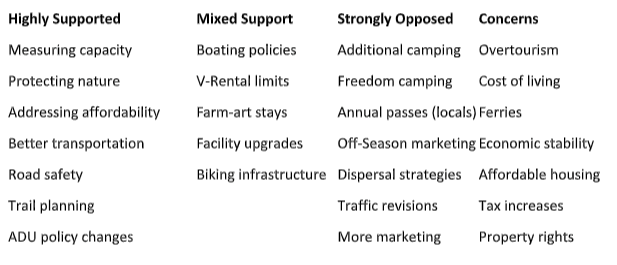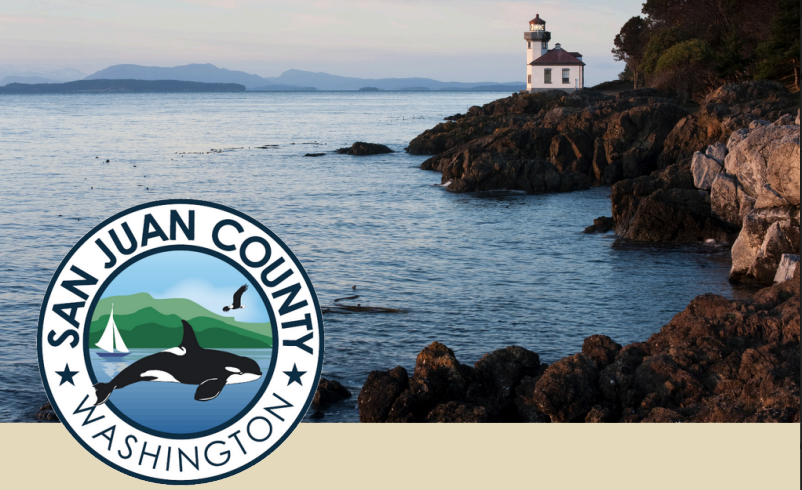||| BY MATTHEW GILBERT, theORCASONIAN OP/ED REPORTER |||
The long wait for the release of comments to the draft San Juan Islands Destination Management Plan (SDMP) finally ended on July 8 when the results were presented to the County Council by Kendra Smith, Director of Environmental Stewardship, and Angela Broderick, Climate and Sustainability Coordinator. Smith began with a mea culpa, citing “bad timing” and a blowup of misinformation for the tsunami of (largely negative) reactions that followed the release of the plan in September last year. “Overall, the work was solid technically, but there were a couple of items that elicited an emotional response.”
The Public Analysis and Debrief Report [go to p. 44] cited a number of issues that staff felt unduly influenced public comments, from the tail end of the pandemic limiting public engagement and the rejection of the county’s road levy to contention over the Zylstra Lake Trail project on San Juan, general economic uncertainty, and “exceptional” ferry service disruptions, causing residents to feel “beleaguered” when the study was released. Turning up the heat was a misinformation campaign of postcards and social media rhetoric detonated by an anonymous group called “Concerned Citizens” claiming that the study was mandating (usage) tax increases and presenting a black or white scenario. It was, in short, a perfect storm of simmering unease that exploded into more than 900 comments (approximately 80% from county residents), nearly half of which were deemed “Non-Supportive” by the staff’s qualitative analysis with another third giving the plan “Mixed Support.”
So let’s take a breath . . .
A History of Ambiguity
As efficiently described in the report, the tourism “conundrum” has a long history in the San Juans, reaching back to Waldron resident South Burn’s study in 1983 in which he called for “local tourism planning to protect the environment and ensure economic benefit among all residents.” This was followed closely by a report to the County Commissioners in 1985 concluding that “the primary tourist resource of San Juan County is its beautiful natural environment [which] must be protected to the benefit of all.”
In 1993, another effort was made to establish a baseline of understanding on the tourism industry’s influence, with a focus on the ferry system’s ability to better meet local needs, the state and impact of housing and vacation rentals, and long-term economic development to lessen reliance on tourism income. Its final conclusion: “Tourism could offer economic stability but not at the cost of the local way of life.”
Thirty years later, much – or little, depending on your point of view – has changed. Visitor traffic and residential growth have steadily increased and slowly reshaped island life, while the county continues to struggle with how to preserve “island character” and still meet the economic needs of residents. The recently completed SDMP draft, and the analysis of the 916 comments it inspired, is a testament to this enduring conflict however “beleaguered” residents may have felt at the time they put pen to paper – or fingers to keys.
A Fractured Roadmap
Despite the many caveats, the comments provided an updated barometer of where residents stand on a wide range of issues:

[Note: Approx. 12% of the comments (n = 113) came from outside the county but were not separated out from the overall analysis. Those with clear county residency were distributed among the four islands in a reasonable proportion to their population share.]
In speaking to what the staff identified as “Hot Topic” issues – those in the Strongly Opposed category – Broderick again noted that much of the public’s discontent was due to misunderstanding and some missteps on the part of the county (“poor word choices”) when framing the study.
“[T]he use of actionable language misled folks to believe that actions were ready to be implemented when in fact these were early-stage exploratory proposals (some of the details of which were lost in the Appendix, e.g., that pass fees might have been waived for residents). The freedom camping initiative was to develop clearer regulations to protect the islands from negative impacts. The west side road proposal was to assess feasibility and to initiate engagement with neighbors. Select camping expansions were to alleviate the seasonal worker housing crunch [while] the aim of the SDMP marketing strategy was to reallocate funds toward stewardship . . . while looking to bolster shoulder seasons to alleviate the boom-and-bust cycle.”
Lessons Learned and Next Steps
The most important takeaway from the years it took from project start to finish (at a cost of $200k+ of LTAC funds) was scope. As the report states, “The planning process was never meant to solve the big picture challenges of Island living, such as affordable housing, ferry service, mobility, or economic development [and yet] the overwhelming community desire for these challenges to be addressed led to a disconnect in expectations and, ultimately, disappointment.”
Not surprising given that the impacts of tourism in the San Juans has all the characteristics of what has been described as a “wicked problem”: a Rubik’s Cube of interdependent factors and interconnected social complexities. Which is why, in the final analysis, the recommendation was to acknowledge the entangled nature of tourism with nearly every aspect of island life and to address those various relationships with “clear County policy and strategic thinking” (e.g., in the Comp Plan, the Housing Assessment). In addition, staff advocated for:
- Deeper collaboration with departments and partners
- Improved effort at public engagement and education
- A more rigorous exploration of funding mechanisms (e.g., the cost of adding a mile of bike lanes has been rumored to be $3M/mile)
- A narrower and re-framed focus for the “next” plan (Phase 2)
“Our situation is not unique,” concluded Broderick. “We will never make everyone happy, and you can’t control but only manage tourism.” The latter being an arguable point as locales around the world are starting to take matters into their own hands – or at least trying. (See the recent uproar in Barcelona – and elsewhere in Europe – as just a few examples.)
The county commissioners had little to add; the staff’s report was thorough. Jane Fuller acknowledged that the lessons learned were indeed “huge.” “What are we lacking in terms of policy direction that could help ground this process?” she asked. “We need to internally digest this document and share it with our various consultants. This issue touches on many areas.” One of which was the next rabbit hole on the council members’ agenda: The county’s role in managing tourism via the Lodging Tax Advisory Committee (LTAC) and the upcoming renewal of the Visitors Bureau contract. As Wolf observed, “There’s significant information we’re going to need in our discussion about the Visitors Bureau in this report, and I’m trying to gauge what the public sentiment is.”
To Be or Not to Be
The future of the Visitors Bureau was a clear flashpoint in the comments, the report stating that, “There was consistent feedback that the Visitors Bureau’s marketing budget should be reduced or even eliminated, citing concerns that promotion leads to increased pressure on a stressed ferry system and worker housing needs. Some commenters also felt it was inappropriate for marketing and destination management to be overseen by the same organization.” There was also strong resistance to shoulder season marketing and dispersal strategies. As summarized by Wolf, “There’s a basic conflict here that gets to the root of our economy: If we are going to have a tourism-driven economy, six months is not enough to sustain livelihoods. We should shift more business to the shoulders. But if the public doesn’t want more tourism, what should happen going forward? How would this affect (the $350k) the county releases to the VB for promotion?”
In the video recording of the July 8 proceedings, this discussion begins at approximately the 1:48 mark as Brandon Andrews, San Juan Parks and Fairs director, describes the legal limits of how LTAC monies can be used (RCW 67.28.1816) – essentially for “promotion,” which can also include, however creatively, an emphasis on “stewardship.”
There is currently no sunset on the lodging tax, although the county’s contract with the Visitors Bureau was converted to yearly pending the findings from the SDMP, which clearly suggested significant resistance to business as usual. (To that, Fuller felt the public comments were not “universally representative.” Wolf pushed back, while Andrews wondered if “the public has lost the forest for the trees.”) With the specter of a Fall renewal, discussion is heating up on how to move forward: whether to refine the VB’s scope of work, amend the contract, divert funds to organizations such as the Chambers of Commerce, or absorb its function into the county. [Sedona’s tourism bureau actually fired the city over conflicts around destination marketing strategies.]
At the July 22 Council meeting, Andrews will seek direction on next steps after presenting information on municipalities that run their own destination marketing functions and a proposed scope of work for the next Visitors Bureau contract. To learn more about LTAC and the Bureau, GO HERE [Orcasonians Libi Geddes and Nancy Stillger are on the committee] and HERE.
**If you are reading theOrcasonian for free, thank your fellow islanders. If you would like to support theOrcasonian CLICK HERE to set your modestly-priced, voluntary subscription. Otherwise, no worries; we’re happy to share with you.**









Thank you Mathew for your excellent analysis of the 7/08/24 County task force meeting DMP public comments debrief.
I would like to add the following from my notes of the meeting for the public’s awareness as well–
It should be noted that there were no comments taken during the public comment period.
In late 2021 LTAC requested the Climate and Sustainability Dept. to draft the destination management plan (DMP) in 2021.
Moving forward–
The county will be posting the (public) comment analysis report on “Engage.”
The county council agreed to put a pause on tourism management for the year (closing this project down).
The county is not going to go forward with a final draft at this time… “down the road with a new project.”
The county is contemplating opening up an element of the Comp Plan and contemplate tourism, and then come back with a much more scaled down program.
The county is hoping that the Comp Plan will address many of the issues in the (DMP) document.
The Environmental Stewardship Dept. stated that this had been taking time away from climate related work.
The recommendations from the Lodging Tax Committee (LTAC) were:
* Develop a Destination leadership Team organized by DMMO.
* Ensure destination marketing and management are equivalent endeavors by creating an annual budget that balances marketing with stewardship programming and visitor management.
* Develop a promotion strategy that focuses on shoulder and off-season and connects visitors with unique island offerings such as local food purveyors, farms and farm stays, artists, craftspeople, special events and other experiences.
* Focus seasonal destination marketing to the time period of October through May and shift to promotion of stewardship activities from June through September.
* Establish and maintain an eco-certification program for tourism businesses and non-profits in San Juan County.
* Establish ferry-based stewardship orientation program, apprx. June through September, via in-person education and/or video education.
*Work collectively with destination Leadership Team to establish a cooperative use statistics program to track visitation impacts and make data-driven decisions, primarily with the use of Datafy data.
* Track visitor usage of bike tours and rentals, whale-watching tours, kayaking tours and rentals, photography tours, boating, car rentals. etc. operating on county lands and waters.
What are Council’s Options?
*Amend and renew existing contract w/ Visitor’s Bureau
* w/ Existing Funding Formula
* Create an RFQ for amended contract
* w/ Existing Funding Formula
* Amend Funding Formula – Flat fee vs. Base fee plus incentives
* Allocate Greater Funds to Chamber Organizations
* Work w/ LTAC committee to bring DMMO function internal to the County
49:09– *One area almost all commenters supported were the island environment and the quality of life.”
56:30– “There was good support for additional monitoring metrics and analysis of visitation and its potential impacts.”
1:20:50 Cindy Wolf– “You talk about a consistent theme in regards to promotion, a consistent theme was to discontinue promotion. Does consistent have a number attached to it?”
Angela Broderick– “I believe the wording was reduce or eliminate. There is not a number attached to that, but it would certainly be possible to review that section of comments and quantify that, because that contains two sentiments, to reduce or eliminate.”
Cindy Wolf– “My concern is that engaging the local Chambers is not reducing or eliminating promotional funding!”
At 1:56:15 Cindy Wolf was asking for clarification regarding LTAC funding as, “there was a lot of squaring public sentiment with the reality of spending this tax money, as there was a lot of public sentiment to reduce or eliminate promotional funding.”
also,
Cindy Wolf–“there was very strong sentiment, 65 to 84% of people said they don’t want shoulder season tourism, and that’s why the original tax was adopted, was to look at trying to spread out business and encourage tourism in the shoulder seasons.”
Jane Fuller remarked that, “the scope of this document was way to broad.”
Well done, Matthew. Thank you.
I am uncomfortable with public officials whose response to criticism is to accuse their constituents of ignorance and/or confusion.
Thank you Matthew! I think the message from the public was quite clear: defund the Visitor’s Bureau (we’re already overrun with tourists), don’t promote the shoulder seasons, don’t expand visitor access into more areas…
and further… Why promote visitors to “support local business” during the tourist season when we should support affordable housing with residents that will support local business all year long? We should also promote more local business that support year round jobs. It’s about developing and supporting a community
Though I agree with the intent behind everyone’s comments, I should say in all fairness, that the public comments do reflect the fact that a lot of people were confused in regards to several of what were called the “hot button topics” within the DMP. Some of this was due perhaps to some of the wording used, or in the manner in which some of the issues were presented within the document itself, while some of this was also the result of mail-outs and articles that were written by the Fri. Har. conservative property rights group that has a history of distorting facts in a manner intended to misframe issues in such a way as to confuse people, and to scare them into voting against something that they don’t like. In observing these kind of lowball tactics I’m reminded of the old maxim, “A lie travels around the world three times before the truth becomes known.”
Having said all that, the tenor of the majority of residents in the county remains consistent over the years, and continues to send a clear message to the council. They don’t want an increase in the number of tourists coming to the San Juans annually, (we have enough), they want less tourism promotion (including funding that would further energize our local Chamber of commerces), they want nothing to do with marketing strategies that will increase the number of tourists during our buffer seasons, or that disperses them into our lesser known areas, (our favorite spots). They want the county council to lobby the state to allow lodging funds to be spent in areas other than tourism promotion, and building & maintaining tourism infrastructure, and they want the county to further policies that better support affordable year-round housing policies rather than quick fix policies like those that will allow seasonal workers to renegade camp throughout our island communities.
Though I was pleased with some of the questions and concerns that were raised by council Fuller (Lopez), and Wolf (Orcas), that show that they are listening to the public, after both initially reading the plan and now listening to the results of the task force review red… flags went up in three areas–
1) Though I was pleased to see the DMP put on hold for the time being, one cannot forget that when it is taken up again next year that it will be under a new pro-tourism, and pro-growth dominant council.
2) Upon realizing that one of the proposals being seriously eyeballed by the county is for the San Juans to adopt one of the official eco-tourism, or green-tourism labels as was promoted by the Pandion Consulting firm, (one of the third party consultants hired by the county to aid in the DMP). Adopting these labels will bump the San Juans up on both the national and worldwide tourism stage, and will give the islands even more promotion, (with these labels having a similar effect on marketing capabilities as does being labeled a “Scenic Byway,” or a “National Monument,” or a “World Heritage site” does. If SJC wants to adopt a more environmentally friendly tourism policy for local businesses, (and I hope that they do, they should have done so a long time ago), I suggest that they use our own highly qualified Environmental Stewardship team and that we create our own certification program under the current climate change resiliency program instead of putting us on the world stage.
3) The disposition of the Visitors Bureau remains unclear. Although council is free to deviate from the LTAC suggestions and take a different approach, ranging from downsizing & internalizing the operation of the current Visitors Bureau into the county itself, or they could keep it the way it is and even lengthy their contract period from one year to two, or even longer. I’m looking forward to further discussions in regards to this.
I’m also looking forward to when the county posts the comment analysis report on the county “Engage” platform for public viewing– https://engage.sanjuancountywa.gov/
Well balanced and thoughtful reporting, Matthew!